Receive a 40% discount on all titles listed below (excluding Korean Cinema in Global Contexts and Sovereign Violence) with the promo code ASFILMAUP40. For Korean Cinema in Global Contexts and Sovereign Violence, use promo code ASFILMAUP20 to receive a 20% discount. Valid when ordering via www.aup.nl until 25th June 2022.
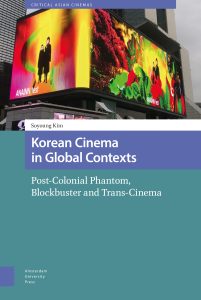 Korean Cinema in Global Contexts. Post-Colonial Phantom, Blockbuster and Trans-Cinema
Korean Cinema in Global Contexts. Post-Colonial Phantom, Blockbuster and Trans-Cinema
Year: 2022
Author: Soyoung Kim
ISBN: 9789463729147
Series: Critical Asian Cinemas
Offering the most comprehensive analysis of Korean cinema from its early history to the present, and including the films of Park Chan-wook, Bong Joon-ho and Kim Ki-young, Korean Cinema in Global Contexts: Postcolonial Phantom, Blockbuster and Trans-Cinema situates itself in the local, Inter-Asian, and transnational contexts by mobilizing the critical frameworks of feminism, postcolonial critique and comparative film studies. It is attentive to an enmeshment of the cinematic, aesthetics, politics and cultural history.
Contents:
Introduction
Part 1. From Pre-Cinematic Culture to Trans-Cinema
- Cartography of Catastrophe: Pre-Colonial Surveys, Post-Colonial Vampires, and the Plight of Korean Modernity
- The State of Fantasy in Emergency: Fantasmatic Others in South Korean Films
- Modernity in Suspense: The Logic of Fetishism in Korean Cinema
- Do Not Include Me in Your “Us”’: Peppermint Candy and the Politics of Difference
- Cine-Mania or Cinephilia: Film Festival and Identity Question
- The Birth of the Local Feminist Sphere in the Global Era: Yeoseongjang and ‘Trans-cinema’
Part 2: Korean Cinema in Trans-Asia Framework
- Inter-Asia Comparative Framework: Postcolonial Film Historiography in Taiwan and South Korea
- Post-colonial Genre as Contact Zone: Hwalgeuk and Action Cinema
- Geopolitical Fantasy: Continental (Manchurian) Action Movies during the Cold War Era
- Anagram of Inter-Asian Korean Film : The Case of My Sassy Girl
- Comparative Film Studies: Detour, Demon of Comparison and Dislocative Fantasy
Index
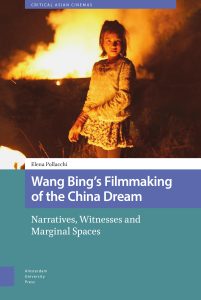 Wang Bing’s Filmmaking of the China Dream. Narratives, Witnesses and Marginal Spaces
Wang Bing’s Filmmaking of the China Dream. Narratives, Witnesses and Marginal Spaces
Year: 2021
Author: Elena Pollacchi
ISBN: 9789463721837
Series: Critical Asian Cinemas
This volume offers an organic discussion of Wang Bing’s filmmaking across China’s marginal spaces and against the backdrop of the state-sanctioned ‘China Dream’. Wang Bing’s cinema gives voice to the subaltern. Focusing on contemporary China, his work testifies to a set of issues dealing with inequality, labour, and migration. His internationally awarded documentaries are considered masterpieces with unique aesthetics that bear reference to global film masters. Therefore, this investigation goes beyond the divides between Western and non-Western film traditions and between fiction and documentary cinema. Each chapter takes a different articulation of space (spaces of labour, history, and memory) as its entry point, bringing together film and documentary studies, Chinese studies, and globalization studies. This volume benefits from the author’s extensive conversations with Wang Bing and insider observations of film production and the film festival circuit.
Contents:
Acknowledgements
Foreword by Alberto Barbera
INTRODUCTION
- The relevance of Wang Bing’s filmmaking
- Themes, form and narrative structure: A linked approach to Wang Bing’s filmmaking
- Wang Bing à la Wong Kar-wai
- Genesis and book’s structure
WANG BING’S CINEMATIC JOURNEY: A COUNTER-NARRATIVE OF THE CHINA DREAM
- The centrality of space in Wang Bing’s narrativized reality
- Chinese marginal spaces and uneven development
- Wang’s counter-journey of the China Dream
- Spaces in Wang Bing’s oeuvre: an overview of the films and issues at stake
HISTORY IN THE MAKING: THE DEBUT EPIC TIEXI QU: WEST OF THE TRACKS
- The debut epic Tiexi qu: West of the Tracks and its context
- West of the Tracks as a contemporary cinematic reportage
- Filming ‘history in the making’ and the legacy of the Lumière films
- Towards an epic of labour: from Terrence Malick’s Days of Heaven to West of the Tracks
SPACES OF LABOUR: THREE SISTERS, ‘TIL MADNESS DO US PART, BITTER MONEY
- Filming spaces of labour and cinema as labour
- The transition from the industrial space of Tiexi to rural and marginal spaces
- Three Sisters: an epic of survival reminiscent of John Ford’s The Grapes of Wrath
- Duration in Wang Bing’s cinema: the case of Three Sisters and Alone
- No Way Out: from Three Sisters to ‘Til Madness Do Us Part
- ‘Til Madness Do Us Part: the camera work between ‘madness’ and ‘love’
- Reaching the new centres of labour: Bitter Money
- Bitter Money: earning money in hardship
SPACES OF HISTORY AND MEMORY: THE WORKS ON THE ANTI-RIGHTIST CAMPAIGN
PART I – A space too much: The Ditch
- The genesis of The Ditch (2004-09)
- The Ditch: carving out a space for documenting the past
- Historical spectacles: Wang Bing’s The Ditch and Pier Paolo Pasolini’s Salò (1975)
- Ghosts of the past: Wang Bing’s The Ditch and Brutality Factory and Pedro Costa’s Colossal Youth
PART II – Spaces of Memories: Dead Souls
- From Fengming: A Chinese Memoir to Dead Souls
- The genesis of Dead Souls
- Spaces for survival: archiving audiovisual witnesses
- The act of filming and spaces of death
- Wang Bing’s Dead Souls and Claude Lanzmann’s Shoah (1985)
COLLECTIVE SPACES – INDIVIDUAL NARRATIVES: MAN WITH NO NAME, FANG XIUYING, GAO ERTAI – BEAUTY LIVES IN FREEDOM
- Man With No Name: individual spaces of self-isolation
- Fathers and Sons: individual spaces and deteriorating family structures
- Mrs Fang: individual spaces of death
- Mi Niang and Ta’ang: spaces of escape and refuge
- Gao Ertai – Beauty Lives in Freedom: individual spaces of exile
CONCLUDING REMARKS: EXHIBITION SPACES AND SPACES OF HUMAN PRACTICE
Filmography
Bibliography
Index
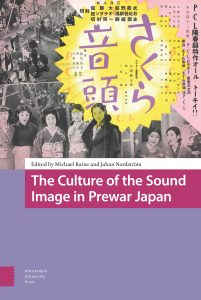 The Culture of the Sound Image in Prewar Japan
The Culture of the Sound Image in Prewar Japan
Year: 2020
Editors: Michael Raine and Johan Nordström
ISBN: 9789089647733
This collection of essays explores the development of electronic sound recording in Japanese cinema, radio, and popular music to illuminate the interrelationship of aesthetics, technology, and cultural modernity in prewar Japan. Putting the cinema at the center of a ‘culture of the sound image’, it restores complexity to a media transition that is often described simply as slow and reluctant. In that vibrant sound culture, the talkie was introduced on the radio before it could be heard in the cinema, and pop music adaptations substituted for musicals even as cinema musicians and live narrators resisted the introduction of recorded sound. Taken together, the essays show that the development of sound technology shaped the economic structure of the film industry and its labour practices, the intermedial relation between cinema, radio, and popular music, as well as the architecture of cinemas and the visual style of individual Japanese films and filmmakers.
Contents:
Introduction (Michael Raine and Johan Nordström)
- A Genealogy of kouta eiga: Silent Moving Pictures with Sound (Sasagawa Keiko)
- Katsutaro’s Trilogy: Popular Song and Film in the Transitional Era from Silent Film to the Talkie (Hosokawa Shuhei)
- Japanese Cinema and the Radio: The Sound Space of Unseen Cinema (Niita Chie)
- Architecture of Sound: The Modernization of Cinematic Space in Japan (Ueda Manabu)
- ‘No Interpreter, Full Volume’: the Benshi and the Sound Transition in 1930s Japan (Michael Raine)
- The Image of the Modern Talkie Film Studio: Aesthetics and Technology at P.C.L. (Johan Nordström)
- The Dawn of the Talkies in Japan: Mizoguchi Kenji’s Hometown (Nagato Yohei)
- The Early talkie frame in Japanese cinema (Itakura Fumiaki)
Index
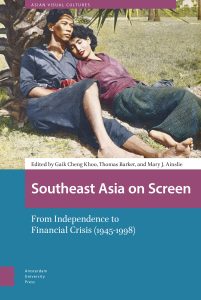 Southeast Asia on Screen. From Independence to Financial Crisis (1945-1998)
Southeast Asia on Screen. From Independence to Financial Crisis (1945-1998)
Year: 2020
Editors: Gaik Cheng Khoo, Thomas Barker and Mary Ainslie
ISBN: 9789462989344
Series: Asian Visual Cultures
After the end of World War II when many Southeast Asian nations gained national independence, and up until the Asian Financial Crisis, film industries here had distinctive and colourful histories shaped by unique national and domestic conditions. Southeast Asia on Screen: From Independence to Financial Crisis (1945-1998) addresses the similar themes, histories, trends, technologies and sociopolitical events that have moulded the art and industry of film in this region, identifying the unique characteristics that continue to shape cinema, spectatorship and Southeast Asian filmmaking in the present and the future. Bringing together scholars across the region, chapters explore the conditions that have given rise to today’s burgeoning Southeast Asian cinemas as well as the gaps that manifest as temporal belatedness and historical disjunctures in the more established regional industries.
Contents:
Introduction: Southeast Asia on Screen: From Independence to Financial Crisis (1945-1998) (Khoo)
Section 1. Independence and Post-WW2 Filmmaking: Nation-building, Modernity and Golden Eras (Ainslie)
Chapter 1. A Nation Imagined Differently: The Critical Impulse of 1950s Indonesian Cinema (Yngvesson and Alarilla)
Chapter 2. The 1950s Filipino Komiks-to-Film Adaptation During the Studio Era (Arriola)
Chapter 3. Pearl Tears on the Silver Screen: War Movies and Expanding Burmese Militarism in the Early Independence Years (Ferguson)
Chapter 4. Gender, Nation and Spatial Mobility in ON TOP OF THE WAVE, ON TOP OF THE WIND (Nguyen)
Chapter 5. Spectacularity of Nationalism: War, Propaganda and Military in Indonesian Cinema During the New Order Era (Irawanto)
Section 2. Key directors (Khoo)
Chapter 6. Two Auteurs in the Indonesian Cinema of the 1970s and 1980s: Sjuman Djaya and Teguh Karya (Hanan and Soehadi)
Chapter 7. Hussain Haniff and the place of the auteur in popular Malay cinema (Driskell)
Chapter 8. Ratana Pestonji and Santi Vina: Exploring the ‘Master’ of Thai Cinema During Thailand’s ‘American Era’ (Ainslie)
Section 3. The Popular (Barker)
Chapter 9. Locating Mike de Leon in Philippine Cinema (Campos)
Chapter 10. Nora Aunor vs Ferdinand Marcos – Popular Youth Films of 1970s Philippine Cinema (Sebastiampillai)
Chapter 11. Transnational Exploitation Cinema in Southeast Asia: The Cases of Indonesia and The Philippines (Barker and Imanjaya)
Chapter 12. Mapping Regional Ambivalence and Anxieties in THEY CALL HER=CLEOPATRA WONG (Siddique)
Chapter 13. The Boonchu Comedy Series: Pre-90s Thai Localism and Modernity (Khuankaew)
Index
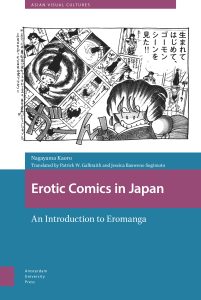 Erotic Comics in Japan. An Introduction to Eromanga
Erotic Comics in Japan. An Introduction to Eromanga
Year: 2020
Author: Kaoru Nagayama. Translated by Patrick Galbraith and Jessica Bauwens-Sugimoto
ISBN: 9789463727129
Series: Asian Visual Cultures
Comics and cartoons from Japan, or manga and anime, are an increasingly common feature of visual and popular culture around the world. While it is often observed that these media forms appeal to broad and diverse demographics, including many adults, eroticism continues to unsettle critics and has even triggered legal action in some jurisdictions. It is more urgent than ever to engage in productive discussion, which begins with being informed about content that is still scarcely understood outside small industry and fan circles. Erotic Comics in Japan: An Introduction to Eromanga is the most comprehensive introduction in English to erotic comics in Japan, or eromanga. Divided into three parts, it provides a history of eroticism in Japanese comics and cartoons generally leading to the emergence of eromanga specifically, an overview of seven themes running across works with close analysis of outstanding examples and a window onto ongoing debates surrounding regulation and freedom of expression in Japan.
Contents:
Translators’ Introduction: Eromanga in the Global Now
Introduction: The Invisible Realm
Part 1: A History of Eromanga Memes Spread
Chapter 1: The Gene Pool of Manga and Gekiga
Chapter 2: The Rise and Fall of Third-Rate Gekiga and the Eve of Bish?jo-Style Eromanga
Chapter 3: Bishojo-Style Eromanga Takes the Stage
Part 2: The Various Forms of Love and Sex Subdividing Desire
Chapter 4: Lolicon Manga
Chapter 5: Big Breasts and Manga
Chapter 6: Little Sisters and Incest
Chapter 7: Disgrace and Training
Chapter 8: Love Stories
Chapter 9: Sadomasochism and Sexual Minorities
Chapter 10: Gender Mayhem
Part 3: Addition to the Expanded Edition (2014)
Eromanga in the Twenty-First Century
Conclusion: Permeation, Diffusion and What Comes After
Pornography Without Sex
Afterword (2006)
Afterword to the Expanded Edition (2014)
Index of Artists and Individuals
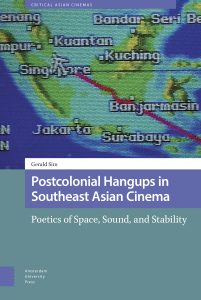 Postcolonial Hangups in Southeast Asian Cinema. Poetics of Space, Sound, and Stability
Postcolonial Hangups in Southeast Asian Cinema. Poetics of Space, Sound, and Stability
Year: 2020
Author: Gerald Sim
ISBN: 9789463721936
Series: Critical Asian Cinemas
Postcolonial Hangups in Southeast Asian Cinema: Poetics of Space, Sound, and Stability explores a geopolitically situated set of cultures negotiating unique relationships to colonial history. Singaporean, Malaysian, and Indonesian identities are discussed through a variety of commercial films, art cinema, and experimental work. The book discovers instances of postcoloniality that manifest stylistically through Singapore’s preoccupations with space, the importance of sound to Malay culture, and the Indonesian investment in genre.
Contents:
Acknowledgments
Introduction: Expanding the Postcolonial Map
An Unfamiliar Postcoloniality
Touchstones in Postcolonial Film Studies: On Style and Practice
Strategies Old and New
Cold Wars and Methodological Debates
Chapter 1: Postcolonial Spatiality: Singapore Maps its Cinema
Aerial Maps
Affective Colonial Maps
The Persistence of Colonial Spatiality
Chapter 2: Reorienting Film History Spatially
Finding Singapore in the Impossibilities of Tan Pin Pin
The Vexed Images of Singapore’s New Wave
Chapter 3: Postcolonial Cacophonies: Malaysia Senses the World
Nancian Soundscapes
Resonant Subjects
Postcolonial Globalism
Chapter 4: Postcolonial Myths: Indonesia Americanizes Stability
A Brief History of Sublation
American Influence
The Road to Reformasi
Conclusion: A Look Forward for Southeast Asian Film Studies
Theorizing Edwin
What Theory and Southeast Asian Cinema Mean to Each Other
Bibliography
Index
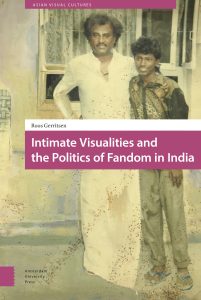 Intimate Visualities and the Politics of Fandom in India
Intimate Visualities and the Politics of Fandom in India
Year: 2019
Author: Roos Gerritsen
ISBN: 9789462985230
Series: Asian Visual Cultures
In Intimate Visualities and the Politics of Fandom in India, Gerritsen explores the circulation of images of a movie star named Rajinikanth. Cities and towns in the south Indian state Tamil Nadu are consistently ornamented with huge billboards, murals and myriad posters featuring political leaders as well as movie stars. A selective part of these images is put up by their fan clubs. Tamil movie fans typically manifest themselves by putting up images of their star in public spaces and by generating a plethora of images in their homes. Gerritsen argues that these images are a crucial part of the everyday affective modes of engagement with family members and film stars but they are also symbolizing the political realm in which fans situate themselves. At the same time, Gerritsen shows how these image productions seem to concur with other visual regimes articulated in government restrictions, world class imaginaries and upper class moralities as presented on India’s urban streets.
Contents:
Introduction
- Keeping in control: The figure of the fan in the Tamil film industry
- Intimacy on display: Movie stars, images, and everyday life
- Vexed Veneration: The politics of fandom
- Public intimacies and collective imaginaries
- Chennai Beautiful: Shifting urban landscapes and the politics of spectacle
Epilogue
References
Index
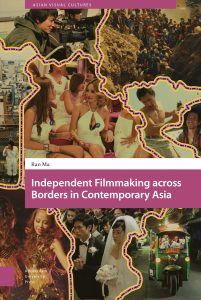 Independent Filmmaking across Borders in Contemporary Asia
Independent Filmmaking across Borders in Contemporary Asia
Year: 2019
Author: Ran Ma
ISBN: 9789462986640
Series: Asian Visual Cultures
Independent Filmmaking across Borders in Contemporary Asia examines an array of auteur-driven fiction and documentary independent film projects that have emerged since the turn of the millennium from East and Southeast Asia, a strand of transnational filmmaking that converges with Asia’s vibrant yet unevenly developed independent film movements amidst global neoliberalism. These projects bear witness to and are shaped by the ongoing historical processes of inter-Asia interaction characterized by geopolitical realignment, migration, and population displacement. This study threads together case studies of internationally acclaimed filmmakers, artists, and collectives such as Zhang Lu, Kuzoku, Li Ying, Takamine Go, Yamashiro Chikako, and Midi Z, all of whose transborder journeys and cinematic imaginations disrupt static identity affiliations built upon national, ethnic, or cultural differences. This border-crossing filmmaking can be viewed as both an aesthetic practice and a political act, reframing how people, places, and their interconnections can be perceived — thereby opening up possibilities to reimagine Asia and its connections to globalization.
Contents:
Introduction: Beyond the Homeland and Diaspora
Chapter One. Art of the Dissensual-Independent Border-Crossing Cinema in Asia
Chapter Two. A Landscape Over There: Rethinking Translocality in Zhang Lu’s Border-Crossing Films
Chapter Three. Fading Hometown and Lost Paradise–Kuzoku’s Politics of (Dis)location
Chapter Four. Li Ying’s Films of Displacement: Towards an Im/Possible Chinese-in-Japan Cinema
Chapter Five. Okinawan Dream Show: Approaching Okinawa in Moving Image Works into the New Millennium
Chapter Six. Homecoming Myanmar: Midi Z (Zhao Deyin)’s Migration Machine and a Cinema of Precarity
Postscript: The Promise of Subversive Art
Index
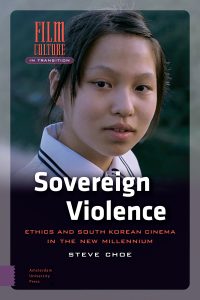 Sovereign Violence. Ethics and South Korean Cinema in the New Millennium
Sovereign Violence. Ethics and South Korean Cinema in the New Millennium
Year: 2018
Author: Steve Choe
ISBN: 9789463725507
Series: Film Culture in Transition
South Korea is home to one of the most vibrant film industries in the world today, producing movies for a strong domestic market that are also drawing the attention of audiences worldwide. This book presents a comprehensive analysis of some of the most well-known and incendiary South Korean films of the millennial decade from nine major directors. Building his analysis on contemporary film theory and philosophy, as well as interviews and other primary sources, Steve Choe makes a case that these often violent films pose urgent ethical dilemmas central to life in the age of neoliberal globalization.
Contents:
Introduction
Peppermint Candy (1999), Lee Chang-dong
Chapter One: Unredeemable Images
Bad Guy (2001), Kim Ki-duk; Address Unknown (2001), Kim Ki-duk; Capitalist Manifesto (2003), Gok Kim and Sun Kim
Chapter Two: Love Your Enemies
JSA (2000), Sympathy for Mr. Vengeance (2002), and Oldboy (2003), Park Chan-wook
Chapter Three: Male Repetitions
Virgin Stripped Bare by Her Bachelors (2000), Woman is the Future of Man (2004), and The Day He Arrives (2011), Hong Sang-soo
Chapter Four: The Face and Hospitality
N.E.P.A.L.: Never Ending Peace and Love (2003), Park Chan-wook; Time (2006) and 3-Iron (2004), Kim Ki-duk
Chapter Five: Aporias of Forgiveness
Secret Sunshine (2007), Lee Chang-dong; Lady Vengeance (2005), Park Chan-wook
Chapter Six: Compromises of Cinema
Memories of Murder (2003), Bong Joon-ho; Thirst (2009) and I’m a Cyborg, But That’s Ok (2006), Park Chan-wook
Chapter Seven: Aftershocks of the Korean Wave
Poetry (2010), Lee Chang-dong; I Saw the Devil (2010), Kim Ji-woon; The Housemaid (2010), Im Sang-soo
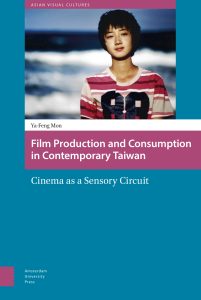 Film Production and Consumption in Contemporary Taiwan. Cinema as a Sensory Circuit
Film Production and Consumption in Contemporary Taiwan. Cinema as a Sensory Circuit
Year: 2016
Author: Ya-Feng Mon
ISBN: 9789089648884
Series: Asian Visual Cultures
This book uses the potent case study of contemporary Taiwanese queer romance films to address the question of how capitalism in Taiwan has privileged the film industry at the expense of the audience’s freedom to choose and respond to culture on its own terms. Interweaving in-depth interviews with filmmakers, producers, marketers, and spectators, Ya-Fong Mon takes a biopolitical approach to the question, showing how the industry uses investments in techno-science, ancillary marketing, and media convergence to seduce and control the sensory experience of the audience-yet that control only extends so far: volatility remains a key component of the film-going experience.
Contents:
Acknowledgements
Chapter One: Through the Nexus of Bodies and Things: Introduction
Chapter Two: Mediated Knowledge: Methodology
Chapter Three: Bodily Fantasy: Embodied Spectatorship and Object Intervention
Chapter Four: Sensory Linkage: The Politics of Genre Film Making
Chapter Five: Intimacy: Internet Marketing as Collaborative Production
Chapter Six: Indeterminacy: Control and the (Un)productive Body
Chapter Seven: Mediation and Connections in a Precarious Age
Conclusion
Bibliography
Index
Notes